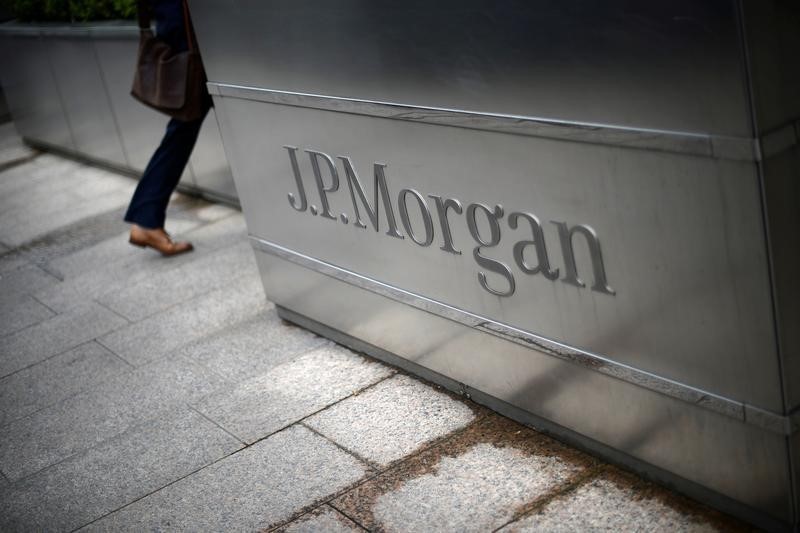By David Henry and Sweta Singh
(Reuters) - JPMorgan Chase & Co (N:JPM) is lending more and keeping a lid on expenses to combat the scourge of low interest rates, allowing management to stick to financial goals for the year.
JPMorgan, the largest U.S. bank by assets, beat subdued expectations, reporting a 1 percent slide in second-quarter earnings on Thursday, in the face of historically low rates, volatile markets and questions about its future in one of Europe's biggest economies.
Chief Financial Officer Marianne Lake struck a resilient tone when discussing results, saying JPMorgan would be at the higher end of management's forecast for 2016 loan growth and was also on track to reach a cost-cutting target.
During the second quarter, JPMorgan's average book of core loans – those related to ongoing businesses it plans to maintain – grew 16 percent, with particular expansion in mortgages and commercial real estate. Even as deposits grew, the portion it lent out also rose to 66 percent, compared with 61 percent a year ago and 64 percent in the prior quarter.
The bank's share price climbed 2 percent in afternoon trading to $64.42 after it reported results.
"We had broad-based demand for loans pretty much across categories," Lake said on a conference call with journalists. "I would say that that speaks well for the U.S. economy."
Growing the loan book is especially important as JPMorgan, like other banks, faces extreme challenges in earning money on idle deposits because of very low rates. Wells Fargo & Co (N:WFC) and Citigroup Inc (N:C) the third- and fourth-biggest U.S. banks, report results on Friday, providing more insight into the health of the industry.
The difference, or spread, between 10-year and two-year U.S. Treasuries, an indicator of how much profit banks can make from loans, dropped to 75 basis points on Friday, its lowest level since late 2007.
The Fed last raised rates in December, by 0.25 percentage points, after keeping them near zero for almost a decade. At the start of the year, further rate hikes were widely expected but now Wall Street is uncertain whether the Fed will raise rates at all this year.
Declining rates put pressure on the amount of money banks can earn relative to their cost of funding, known as net interest income. JPMorgan's net interest income fell during the second quarter relative to the previous one.
Another symptom of the bank's struggle with low rates was its return on tangible common equity, a key measure of profitability. It fell to 13 percent from 14 percent a year earlier. Management has said it should be about 15 percent, but to get there the bank needs higher rates.
However, Lake said low rates have sparked "robust" demand for new loans, which will help boost net interest income and keep net interest margins stable through the end of the year. He expects the bank to come in at the higher end of its forecast loan growth for 2016, a range of 10 to 15 percent.
Executives were also quick to defend the pace of loan growth. They described conditions in certain markets as frothy but manageable, and said they were being careful, and JPMorgan's portfolio of loans was solid.
When an analyst described the bank's commercial real estate loan book as "growing like a weed" during a conference call, Lake responded: "Growing like a sunflower, not like a weed."
TOUGH ENVIRONMENT
Overall, JPMorgan's second-quarter net income slipped to $6.2 billion (£4.6 billion) in the second quarter ended June 30 from $6.3 billion a year earlier. Net revenue rose 3 percent to $25.2 billion.
Earnings per share of $1.55 handsomely beat the average analyst estimate of $1.43 per share, according to Thomson Reuters I/B/E/S. Analysts had reduced their forecasts for big banks in recent weeks.
(For a graphic on bank earnings and stock prices, click here: http://tmsnrt.rs/1mZb4h8)
Even as business grew last quarter, JPMorgan managed to keep down costs, apart from technology. Overall operating expenses fell 6 percent compared with the year-earlier period.
"JPMorgan continues to execute really well in a tough environment," said Evercore ISI analyst Glenn Schorr, noting that the bank beat his expectations not only in loan growth, but also in fixed income trading, investment banking and expenses.
JPMorgan stock helped push the S&P 500 and the Dow to fresh highs. However, financial firms are underperforming the wider jump in U.S. stocks. The sector in the S&P (SPSY) is down 1.23 percent year to date, the only loser in a wider index up 5.88 percent in the same period.
JPMorgan is the first U.S. bank to announce results since Britain voted on June 23 to leave the European Union.
The vote to leave the EU, known as Brexit, helped push JPMorgan's fixed-income trading revenue up 35 percent last quarter, as investors scrambled to react to the vote. So far in the third quarter, trading volumes have been "fine," but a normal seasonal decline is expected, Lake said.
In addition to its impact on interest rates and markets, Brexit also raised questions about whether banks will shift some of their London operations to other cities.

After the vote, JPMorgan said it was considering changes that could result in moving some of its 16,000 UK-based employees. On Thursday, Lake said dialogues about staff moves are "only in their infancy."